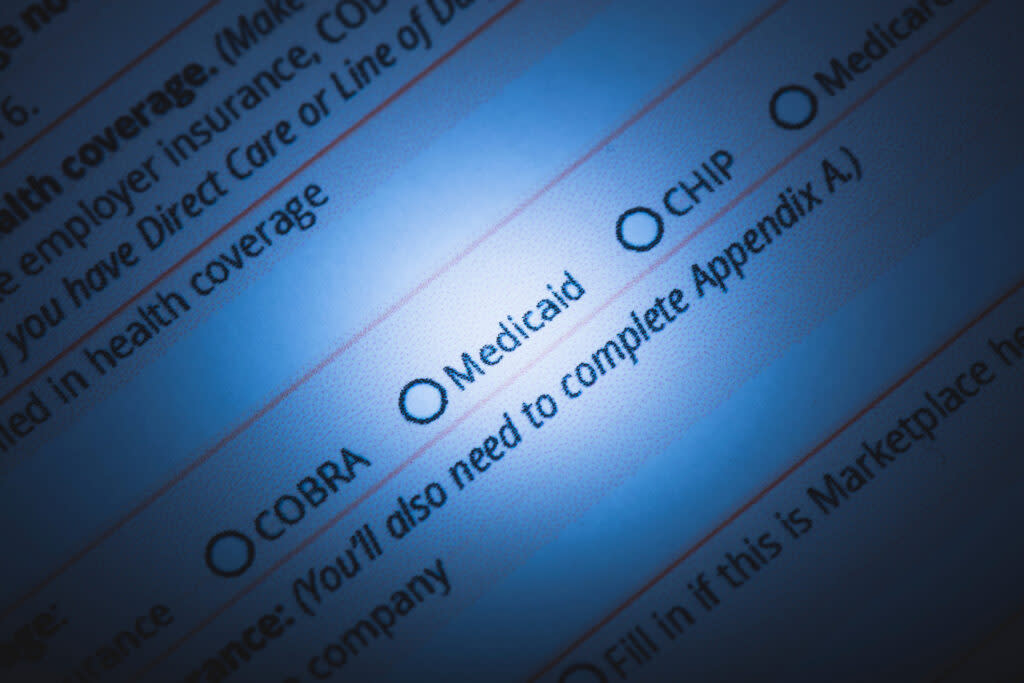Idaho removed 185,000 people from Medicaid. Over a fifth have re-enrolled.

More than a fifth of Idahoans removed from Medicaid have since-re-enrolled, new data shows. (Getty Images)
Medicaid helped Randi La Salle avoid difficult decisions.
Should she pay for health care for her and her four children? Or their food or school supplies?
La Salle, who worked three jobs, and her family were among roughly 185,000 Idahoans who over the past year lost health insurance coverage on Medicaid, which largely insures people who are low-income or have disabilities.
Starting April 2023, states were allowed to start removing people from Medicaid, after a three-year federal pause on removals — due to the COVID-19 pandemic — ended.
Idaho pursued a fast timeline for resuming Medicaid eligibility reviews, known as Medicaid unwinding. So far, more than a fifth — 22% — of Idahoans removed from Medicaid have since-re-enrolled, new data shows. That’s over 40,000 people, according to data shared by the Idaho Department of Health and Welfare.
“The numbers are really startling,” Ivy Smith, health policy specialist at Idaho Voices for Children, said in response to Idaho’s Medicaid re-enrollment data. “And they demonstrate a clear picture of what we knew was going to be a problem from the start. Idaho’s Medicaid unwinding plan was very aggressive in terms of their timeline.”
Idaho officials defend Idaho’s Medicaid unwinding process as a success.
State officials “went above and beyond” to reach out to Medicaid enrollees, said Shane Leach, administrator of the Idaho Department of Health and Welfare’s Division of Self-Reliance.
Health officials also met a legislative request to wrap up Medicaid unwinding in six months and prioritize people that health officials hadn’t heard from in recent years, Leach said.
“You will see all these numbers start to average out in the long term. And so what you see from Idaho is just an indicator of what I think will be present for a lot of other states across the country,” Leach said. “But again, that’s going to take time for other states to get caught up. And even then … other states have different rules and requirements for how they do Medicaid. So even that makes it even harder to compare.”
GET THE MORNING HEADLINES DELIVERED TO YOUR INBOX
Idahoans eligible for Medicaid can re-enroll anytime
Idaho health officials have stressed anyone can re-enroll for Medicaid at any time, which also offers retroactive coverage that extends back 90 days.
“There really should be no gap in coverage,” Leach said.
La Salle’s oldest son re-enrolled in Medicaid last fall.
But not her and the rest of her family, who she said health officials found ineligible because she earned $75 over the monthly income cap.
Her oldest son got back on Medicaid, La Salle said, because officials counted income from her ex-husband.
Months later, La Salle enrolled in private insurance for $800 a month.
“Because of that $75, I had to choose — once I put my kids on my insurance — between them eating or them having insurance,” she said. “Or me eating. Or them eating.”
About 17,500 Idahoans, or 44% of those who regained Medicaid, re-enrolled within 30 days, Leach said.
Smith said some Idahoans first found out they lost Medicaid coverage when they went to the pharmacy. That put some in a “financial bind,” she said.
“The system’s just not easy to navigate,” La Salle said. “And there are some people who are just gonna give up and then they have no access to any kind of Medicaid or insurance at all.”
Randi La Salle and her oldest son Alex Santos, 17, pose for a photo while shopping for school clothes. (Courtesy photo)
Idaho finished Medicaid unwinding in six months. But there are still accounts left to review.
Idaho is the first state to drop below Medicaid enrollment levels last seen before the pandemic, said Jennifer Tolbert, deputy director for KFF’s Program on Medicaid and Uninsured.
Idaho’s Medicaid population declined at the third sharpest rate of all states, falling by 31% during Medicaid unwinding, KFF data shows.
For Medicaid unwinding, some states also initially targeted which Medicaid accounts to review first. But Idaho is the only state that tried to do it in six months, said Meredith Wheeler, senior campaigns manager for Medicaid at the American Cancer Society Cancer Action Network.
Idaho Medicaid has gone from insuring about 450,000 Idahoans to around 350,000 since Medicaid unwinding started, Leach said.
Idaho officials didn’t confirm everyone they removed from Medicaid was ineligible. About 73% of Idahoans lost Medicaid for not replying to the state’s requests for information, according to KFF.
Roughly 138,000 Idahoans lost Medicaid that way, Leach said, which health officials call procedural removals.
Out of all Medicaid renewals Idaho completed, 40% of people lost coverage for procedural reasons, KFF’s data showed. That’s the fifth highest rate in the nation so far. Idaho officials found 15% of Medicaid accounts reviewed were ineligible, while 45% retained coverage, KFF’s data shows.
But Leach said it isn’t good practice to compare Medicaid unwinding results from different states, which adopted different approaches. Some states have held off on processing procedural removals, he said.
Federal regulators have talked about extending Medicaid unwinding past the initially planned 12 months because states aren’t finished, Leach said.
It’s also difficult to compare metrics on Medicaid churn — a term health experts use to describe people who lost Medicaid coverage, and later regained it.
Idaho’s 22% Medicaid churn rate counts the 40,000 Idahoans who regained Medicaid coverage, out of 185,000 Idahoans who state officials ended coverage for, Leach said.
That would show higher churn rates than if officials counted churn relative to the entire Medicaid population, rather than just people removed, said Brad Corallo, senior policy analyst with KFF’s Program on Medicaid and the Uninsured.
“It will be hard to find much comparable data” to Idaho’s churn data, Corallo said. “It’s just a pretty unique timeframe that they are reporting.”
Idaho officials in September finished reviewing the eligibility of 153,000 Idahoans that officials flagged as likely ineligible, either for not replying to the state’s outreach or for information suggesting that they were no longer eligible for Medicaid.
When Idaho concluded that group’s reviews, officials said Idaho’s Medicaid unwinding was complete. Idaho removed 121,000 people in that group.
But Idaho was still working through reviewing the eligibility of all the roughly 450,000 Idahoans on Medicaid by the time federal protections ended.
Almost all Idaho Medicaid accounts have now been reviewed, with only about 3% or more than 14,000 accounts left to review by August, Leach said on March 11.
Idaho officials ‘went above and beyond’ on Medicaid unwinding outreach, official says
Idaho officials started sending letters to people more than two months in advance, Leach said. State officials also sent text messages to people and a final notice about their Medicaid coverage ending, he said.
The Idaho health department “went above and beyond and met all federal requirements,” Leach said.
But the health department’s plan “was not nearly sufficient” to meet Idaho’s fast-tracked unwinding timeline, Smith said.
For instance, Idaho’s renewal notices were only sent out in English and Spanish, Smith said. People who needed translations needed to call the health department, whose wait times have been high throughout Medicaid unwinding, Smith said.
Leach stressed anyone eligible for Medicaid can apply any time.
Because of wait times, “Do people struggle on some different areas? Possibly,” Leach said. But, he said, “anybody can come back and reapply at any point in time for Medicaid. And if they’re eligible, they would be reinstated.”
The results from Idaho’s Medicaid unwinding process shows that while some people lost coverage for being ineligible, the majority on Idaho Medicaid were eligible, Smith said.
Almost half of Idahoans removed from Medicaid were children; Idaho had the third highest child Medicaid removal rate in the nation, according to KFF.
By December, Idaho had removed the ninth highest number of children from Medicaid and CHIP, and tied for the highest rate of child removals, according to federal data.
That worried federal regulators for Medicaid — a program largely paid by the federal government — who urged Idaho officials to ensure kids eligible for Medicaid wouldn’t lose coverage. Idaho officials said they were following federal law in administering their federally approved plan to unwind Medicaid.
Need to get in touch?
Have a news tip?
The Centers for Medicaid and Medicare (CMS) services recently looked into how Idaho handled children’s eligibility during unwinding, Leach said. Federal regulators found a minor error in one case, he said.
The Idaho health department hasn’t received the full report, Leach said. A CMS spokesperson declined to comment on pending audits.
Medicaid to return to routine eligibility reviews
People who are eligible for Medicaid can re-enroll at any time. That means Idaho’s Medicaid “churn” rate could change over time.
KFF research in 2023 found about 41% of people who lost Medicaid re-enrolled in a year.
But “we don’t have churn rates for people re-enrolling for shorter periods of time, like 90 days or 6 months,” Corallo said. That churn rate would likely be lower, he said.
The percentage of Americans with health insurance reached an all-time high of 92% in 2022, in part because of the coverage for Medicaid patients required during the pandemic. But millions of Americans continue to lack insurance. Earlier this year, more than a thousand people came to get free dental, medical and vision care at a mobile clinic in Grundy, Virginia, staffed by students and volunteer medical teams. (Spencer Platt/Getty Images)
“Given that we aren’t even a full year into the unwinding, that can complicate comparisons to state-reported unwinding data,” he said.
About 31% of Idahoans removed from Medicaid got health insurance on Your Health Idaho, the state’s insurance exchange that offers tax credits based on income.
More people are likely uninsured following Medicaid unwinding, Wheeler said, but official numbers aren’t out yet.
Now that it’s been nearly a year since Idaho’s Medicaid unwinding started, Idahoans on Medicaid will go through the usual annual eligibility reviews, Smith said.
La Salle’s oldest son’s review is coming up.
La Salle said she called the Idaho Department of Health and Welfare about his Medicaid account in mid-March.
More than a week later, in a March 24 interview, she said she hadn’t heard back.
“I have called them three times since then. I have no notifications on my account, and I’ve not been called back once,” La Salle said. “We get an automated system every time. It just seems like it’s getting more and more difficult to get ahold of somebody.”
A week later, she said that he’d been re-enrolled. But not her other kids.
The post Idaho removed 185,000 people from Medicaid. Over a fifth have re-enrolled. appeared first on Idaho Capital Sun.



